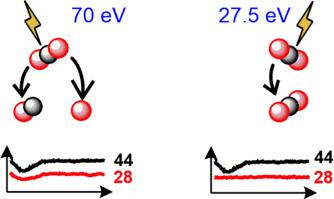当前位置:
X-MOL 学术
›
J. Electroanal. Chem.
›
论文详情
Our official English website, www.x-mol.net, welcomes your
feedback! (Note: you will need to create a separate account there.)
A DEMS approach for the direct detection of CO formed during electrochemical CO2 reduction
Journal of Electroanalytical Chemistry ( IF 4.1 ) Pub Date : 2020-10-01 , DOI: 10.1016/j.jelechem.2020.113842 Christoph J. Bondue , Marc T.M. Koper
Journal of Electroanalytical Chemistry ( IF 4.1 ) Pub Date : 2020-10-01 , DOI: 10.1016/j.jelechem.2020.113842 Christoph J. Bondue , Marc T.M. Koper

|
Abstract Observation of CO formed during electrochemical CO2 reduction using Differential Electrochemical Mass Spectrometry (DEMS) is complicated by the fragmentation of CO2 in the course of the ionization process. Since much more CO2 than CO enters the vacuum of the mass spectrometer, the ion current for mass 28 is dominated by the CO+-fragment of CO2. By reducing the cathode potential of the ion source of the mass spectrometer from −70 V to −27.5 V, fragmentation of CO2 is reduced to a negligible degree. This allows direct observation of electrochemically formed CO by measuring the ionic current for mass 28. We show that this method is superior to matrix calibration in which the ionic current for mass 44 corrected by the CO+/CO2+-intensity ratio is subtracted from the ionic current for mass 28. Using this method, we compare DEMS results for the electrochemical reduction of CO2 at gold electrodes obtained in two different cells, a conventional DEMS cell with the working electrode sputtered onto the membrane in contact with the vacuum and a flow cell where the interface to the vacuum is separated from the working electrode. We show that in the conventional cell at the interface between electrolyte and vacuum, the local CO2 concentration is reduced as the nearby vacuum interferes with the equilibria of reactions involving gases, and the local pH is increased. Therefore, in DEMS cells where the working electrode is positioned in the vicinity of the interface, the onset potential for CO2 reduction and hydrogen evolution are shifted and the observed faradaic efficiency for CO2 reduction are considerably reduced compared to literature values. This can be rectified by using flow cells that allow a spatial separation between vacuum/electrolyte interface and working electrode. We describe how the Dual Thin Layer Cell can be calibrated for detecting CO, thus allowing quantification of evolved amounts of CO from the ionic current for mass 28.
中文翻译:

一种直接检测电化学 CO2 还原过程中形成的 CO 的 DEMS 方法
摘要 使用差示电化学质谱 (DEMS) 对电化学 CO2 还原过程中形成的 CO 的观察由于 CO2 在电离过程中的碎裂而变得复杂。由于进入质谱仪真空的 CO2 比 CO 多得多,因此质量 28 的离子流由 CO2 的 CO+ 片段支配。通过将质谱仪离子源的阴极电位从 -70 V 降低到 -27.5 V,CO2 的碎片减少到可以忽略不计的程度。这允许通过测量质量 28 的离子电流直接观察电化学形成的 CO。 我们表明该方法优于矩阵校准,其中从离子电流中减去由 CO+/CO2+-强度比校正的质量 44 的离子电流对于质量 28。使用这种方法,我们比较了在两种不同电池中获得的金电极上 CO2 电化学还原的 DEMS 结果,一种是传统的 DEMS 电池,其工作电极溅射到与真空接触的膜上,另一种是流通池,其中与真空的界面与真空接触工作电极。我们表明,在电解质和真空界面的传统电池中,由于附近的真空干扰了气体反应的平衡,局部 CO2 浓度降低,并且局部 pH 值升高。因此,在工作电极位于界面附近的 DEMS 电池中,CO2 还原和析氢的起始电位发生了变化,与文献值相比,观察到的 CO2 还原法拉第效率显着降低。这可以通过使用允许真空/电解质界面和工作电极之间空间分离的流动池来纠正。我们描述了如何校准双薄层细胞以检测 CO,从而允许从离子电流中对质量 28 的 CO 释放量进行量化。
更新日期:2020-10-01
中文翻译:

一种直接检测电化学 CO2 还原过程中形成的 CO 的 DEMS 方法
摘要 使用差示电化学质谱 (DEMS) 对电化学 CO2 还原过程中形成的 CO 的观察由于 CO2 在电离过程中的碎裂而变得复杂。由于进入质谱仪真空的 CO2 比 CO 多得多,因此质量 28 的离子流由 CO2 的 CO+ 片段支配。通过将质谱仪离子源的阴极电位从 -70 V 降低到 -27.5 V,CO2 的碎片减少到可以忽略不计的程度。这允许通过测量质量 28 的离子电流直接观察电化学形成的 CO。 我们表明该方法优于矩阵校准,其中从离子电流中减去由 CO+/CO2+-强度比校正的质量 44 的离子电流对于质量 28。使用这种方法,我们比较了在两种不同电池中获得的金电极上 CO2 电化学还原的 DEMS 结果,一种是传统的 DEMS 电池,其工作电极溅射到与真空接触的膜上,另一种是流通池,其中与真空的界面与真空接触工作电极。我们表明,在电解质和真空界面的传统电池中,由于附近的真空干扰了气体反应的平衡,局部 CO2 浓度降低,并且局部 pH 值升高。因此,在工作电极位于界面附近的 DEMS 电池中,CO2 还原和析氢的起始电位发生了变化,与文献值相比,观察到的 CO2 还原法拉第效率显着降低。这可以通过使用允许真空/电解质界面和工作电极之间空间分离的流动池来纠正。我们描述了如何校准双薄层细胞以检测 CO,从而允许从离子电流中对质量 28 的 CO 释放量进行量化。










































 京公网安备 11010802027423号
京公网安备 11010802027423号